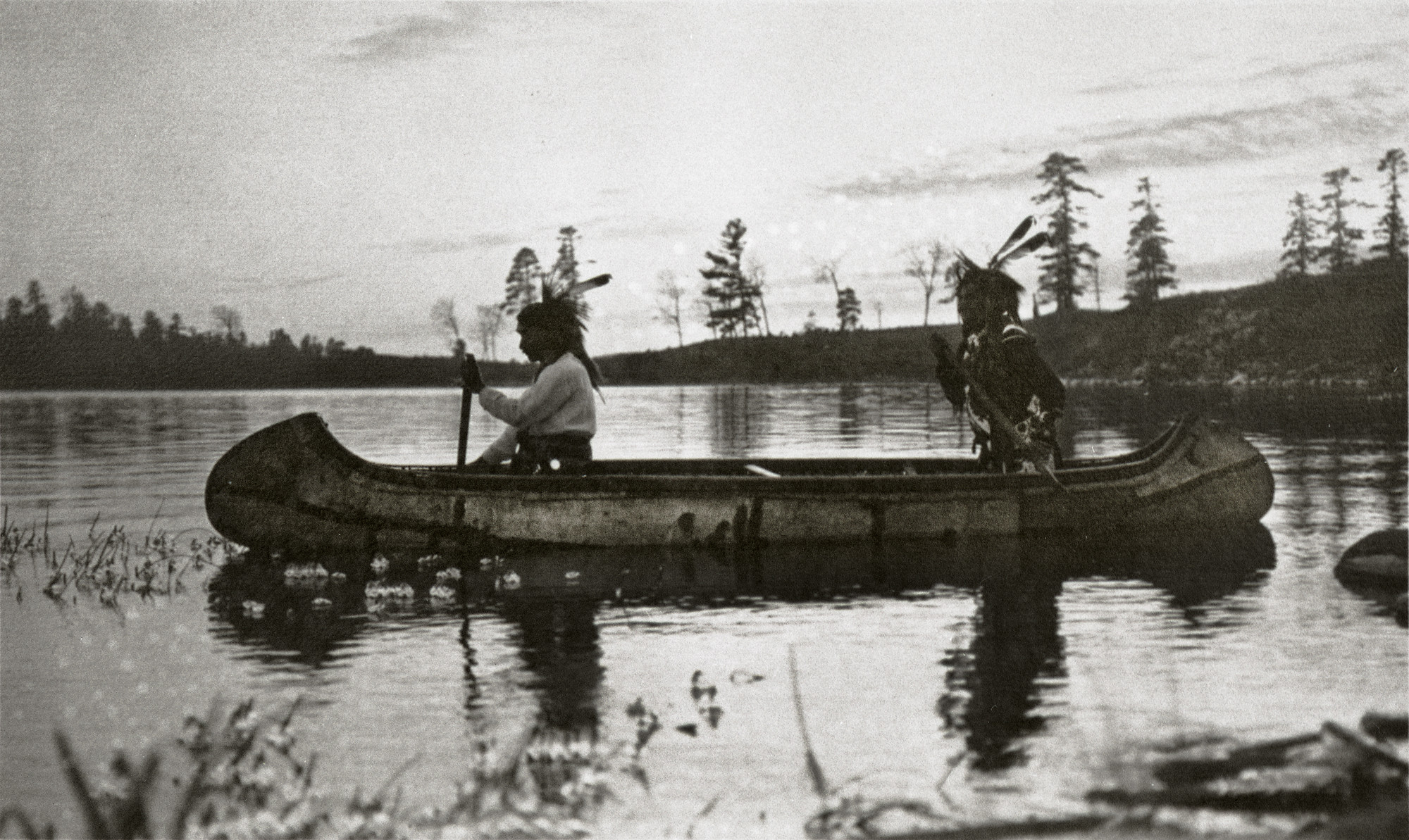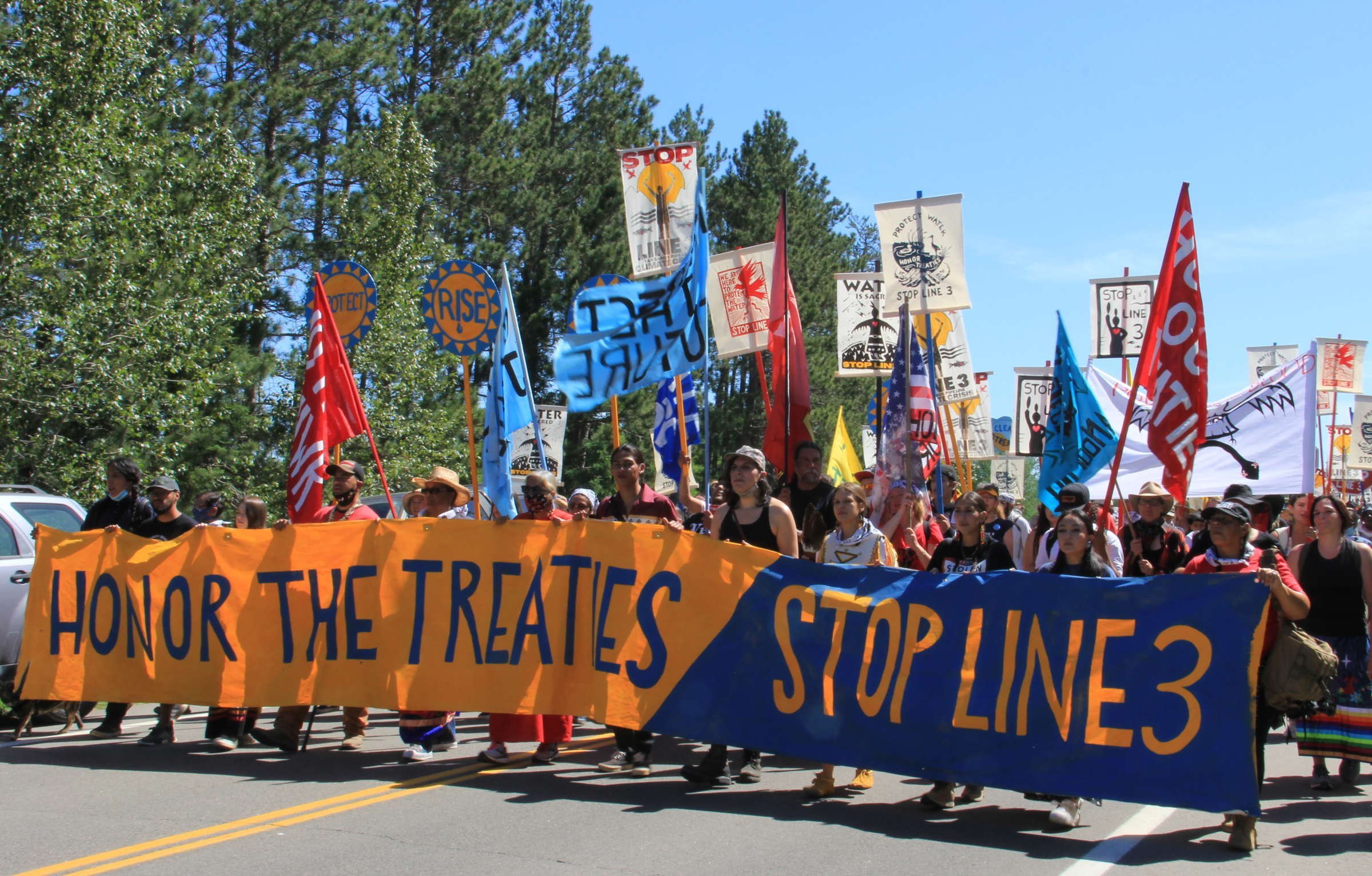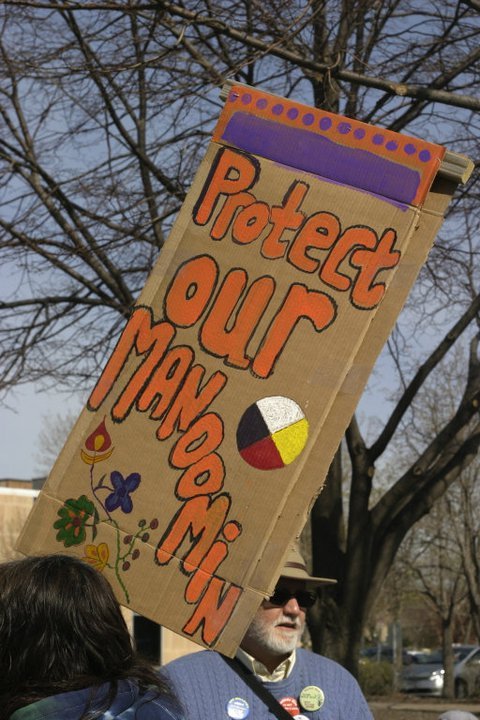Indigenous Environmentalism: The Rights of Manoomin Toolkit
This photograph features two members of the Leech Lake Chippewa tribe (now known as the Leech Lake Band of Ojibwe) in a canoe in the rice fields on Leech Lake. Wild Rice, also known in the Ojibwe language as ‘manoomin’, or ‘the good berry’ is a longtime staple of the Ojibwe diet. Photographer: H. Trevor Booth or M. Harris Cole
Indigenous Environmentalism
The Rights of Manoomin
Toolkit Research by Kianna Pete
introduction
A woman in northern Wisconsin harvests and knocks wild rice off the stems into her canoe using traditional harvesting sticks. Source: Wisconsin Historical Society
Indigenous Peoples make up less than 5% of the world population, but protect over 80% of the Earth’s biodiversity.
For centuries, traditional Indigenous practices have preserved forests, deserts, grasslands, and marine environments. However as the original stewards of the land, Indigenous Peoples are often disregarded in climate justice movements.
Due to colonialism + the western colonial gaze, Indigenous practices that protect Mother Earth are seen as “archaic” and have been outlawed. Legislation, capitalism, and other colonial powers have tremendously impacted Indigenous environmental rights and ways of life.
Indigenous Peoples are integral to the climate justice movement. Their knowledge + practices teach us that collective environmental justice + liberation is possible but not without Indigenous leadership.
definitions
Manoomin
noun - in Ojibwe means “good berry” or “good grain”, it is a wild rice that is culturally significant to the Anishinaabeg peoples
The Rights of Nature & Manoomin
“The Rights of Nature” doctrine is the concept that ecosystems are entitled to rights. For Indigenous Peoples, the relationship with nature is both powerful + spiritual. The Rights of Nature doctrine acknowledges this connection and upholds the protection of various environments. Rights of Nature Laws exist in 30+ Indigenous communities across the world.
In 2018, the White Earth Band of Ojibwe + 1855 Treaty Authority of the Chippewea recognized the Rights of Manoomin, a wild rice that grows in treaty lands or what is now known as, Northern Minnesota. Manoomin is traditionally used in ceremonies and is a vital food source amongst the Ojibwe Peoples. The recognition of these rights would prohibit non-Ojibwe commercialization of these products and protect the cultivation/use of manoomin by Ojibwe peoples.
Recognizing the rights of the specific cultural resources reinforces the sovereignty of Inidgenous Peoples and honors Treaty rights recognized in 1825, 1837, 1854, and 1855 Treaties with the Chippewa and US government. (Rights of the tribe to gather Manoomin + other aquatic plants from public waters on Treaty land)
Wild rice growing in Kathio State Park, MN. Photo: Brett Whaley
“It’s a plant that helped tell us through prophecies where we need to come because we needed to come to the place where food grows on water, and that’s really where we settled ourselves after traveling and migrating.”
- Melonee Montano, a member of the Red Cliff Band of Ojibwe
Threats to Indigenous Peoples
In 2014, Enbridge Energy, a Canadian pipeline company, proposed the expansion of a Line 3 Pipeline that would extend from Alberta, Canada to Superior, Wisconsin. The pipeline would infiltrate untouched ecosystems and treaty territory of Indigenous (Anishinaabe) Peoples. Manoomin is one of the many Indigenous natural resources put at risk due to the construction of Line 3.
This expansion would bring about 3 Million barrels of tar sands per day
Enbridge is responsible for the largest inland oil spill in the US
The pipeline crosses several vital water resources (Mississippi 2x)
The construction of Line 3 is an environmental/climate risk. Beyond this, Line 3 is a threat to tribal sovereignty that breaks treaty negotiations and puts Indigenous lives in danger.
Manoomin & Line 3
On June 4, 2021, the Minnesota Department of Natural Resources (DNR) issued a permit allowing Enbridge to use 5 billion gallons of water for the Line 3 pipeline tar sands.
Already recognized under the Right of Nature + tribal law, Manoomin serves as a plaintiff to contest the diversion of water for the pipeline.
On August 4, 2021, the White Earth Band filed Manoomin, v. Minnesota Department of Natural Resources (Case No. GC21-0428) in the White Earth Tribal Court to enforce the rights of manoomin, the first rights of nature enforcement case to be brought in a tribal court.”
If the case was won, it would establish a legal precedent for Indigenous communities to refute other construction projects that are environmental risks. The case could also address other underlying issues caused by the pipeline.
“The State of Minnesota is ignoring its treaty obligations and tribal laws in allowing the Enbridge corporation to take five billion gallons of water for the construction of the pipeline. This action is about upholding manoomin’s right to exist and flourish as established by tribal law, and about Minnesota’s legal obligations pursuant to the Treaties signed with the Chippewa. All we are demanding is that those Treaties be honored, and manoomin recognized as having the sacred status as recognized by tribal law.”
Frank Bibeau, lawyer for the plaintiffs
Treaty Rights & Indigenous Well-Being
Treaty rights are important for tribal nations because they are documented records that recognize Indigenous well-being. Indigenous systems of governance are often discriminated against, so treaties serve as a foundation for establishing Indigenous rights.
The strength of treaty rights protecting natural resources is challenged by the Manoomin vs. Minnesota case.
The case pins tribal rights against state claims to ownership. According to U.S. Constitutional Law, equal protection should be guaranteed to citizens under the law. The water permit is a violation that selectively & biasly refuses to honor treaty rights, and as a state Minnesota trivializes these agreements that are supposed to protect Indigenous peoples + ecosystems.
Tribal sovereignty which includes water + cultural rights are also impacted by the permit.
Indigenous Environmentalism
Ultimately, the court dismissed the Manoomin vs. Minnesota case on the grounds that the tribal courts + treaty law have no jurisdiction on “unlawful activities that occur off the reservation.”. Despite this outcome, there is a lot to learn from this case.
First and foremost, it exemplifies the neglect towards Indigenous environmentalism. For over 7 years, Indigenous peoples have faced life-threatening situations to stop the construction of Line 3 and its replacement projects. There is an ongoing disregard in policy to address these issues and failure to honor treaties.
Second, it highlights the need for Indigenous Peoples to be at the forefront of climate justice movements. Although manoomin is threatened by pipeline construction projects, it is also vulnerable to climate change effects. In the “2018 Climate Change Vulnerability Assessment” conducted by the Great Lakes Indian Fish & Wildlife Commission, manoomin was categorized as “highly to extremely vulnerable” and was the “most vulnerable species” in the overall assessment. Indigenous identity and culture is deeply connected to the environment. If the environment is at risk, so are Indigenous Peoples.
Third, it reinforces Indigenous beliefs + knowledge about our ecosystems. The Rights of Nature laws and the case for Manoomin integrates personhood into environments. It acknowledges a responsibility to protect and honor ecosystems like all other life. Indigenous Peoples bring forth a perspective that connects us to our surroundings and to reconcile our own environmental impact.
(Left) Indigenous leaders + community allies marched on June 7th, 2021, in Clearwater County, Minnesota. In protest of Enbridge pipeline at the Mississippi River's headwaters, the day's actions called on the Minnesota state officials and the Biden administration to honor Anishinaabe treaty rights. | Image Source: Candice Bernd (Right) Rally at State Capitol - May 2011. Photo Credit - Montana Picard
Treaty rights are important for tribal nations because they are documented records that recognize Indigenous well-being. Indigenous systems of governance are often discriminated against, so treaties serve as a foundation for establishing Indigenous rights.
The Rights of Manoomin
The lawsuit filed by the White Earth Nation specifically requests that ALL water appropriation permits issued to Line 3 be rescinded and for the state to establish consultation processes with the Chippewa for future projects. The White Earth Nation also declare:
Under the grounds that manoomin have certain rights, the water permits violate these rights.
Chippewa possess rights to harvest + protect manoomin as declared in the 1855 Treaty
Chippewa sovereignty + self-determination rights cannot be infringed/violated by governments or businesses
Although the Rights of Nature recognize the sacredness of natural resources, it is also important to note that the White Earth’s use of Rights of Nature is considered a last resort effort to prohibit the construction of Line 3. Human rights cases (sexual assult, land/ water soveriegnty, etc) filed by Indigenous Peoples continued to be ignored by governments. In the fight for climate justice, these issues are intersectional to environmentalism and should be addressed.
Ricer Veronica Skinaway of the Sandy Lake Ojibwe (Photo by Sarah LittleRedFeather)
resources
Organizations
A group to which several members of TRC-Bobcaygeon belong. This group on Indigenous and non-Indigenous members is dedicated to protecting Manoomin and the Indigenous rights to tend and harvest it.
Watch
Action
Further Reading
about the researcher
Kianna was a Spring 2022 Social Media Fellow at IE.
She is currently getting her B.A. in political science and ethnicity & race studies with a specialization in Indigenous/Native studies at Columbia University.
IG: @kianna_pete
Linkedin: Kianna Pete
Twitter: Kianna Pete
References
Climate Change Vulnerability Assessment April 2018 | Great lakes Indian Fish and Wildlife Commission
Minnesota of Department of Natural Resources v. Manoonmin | White Earth Band of Ojibwe Court of Appeals
Rights of Nature Tribal Case May Upend Pipeline | E&E News
Rights of Manoomin | Center for Democratic and Environmental Rights
Manoomin: The Taming of Wild Rice in the Great Lake Regions | Environmental & Society Portal
Who is Manoomin? A Clash Between Culture and Climate Change | Danielle Johnson
First “Rights of Nature” Enforcement Case Filed in Tribal Court | 1855 Treaty Authority
Wild Rice Sues to Stop Oil Pipeline | High Country News
To Stop Line 3 Across Minnesota, an Inidgenous Tribe is Asserting the Legal Rights of Wild Rice | Inside Climate News
Minnesota Hit with Novel “Natural Right” Tribal Lawsuit Over Line 3 | Reuters
Overview of White Earth’s Case of Manoomin v. the State of Minnesota DNR Court Case | Wisconsin Citizens Media Cooperative









